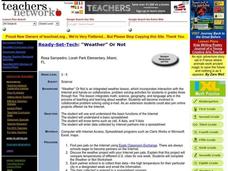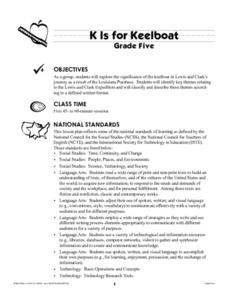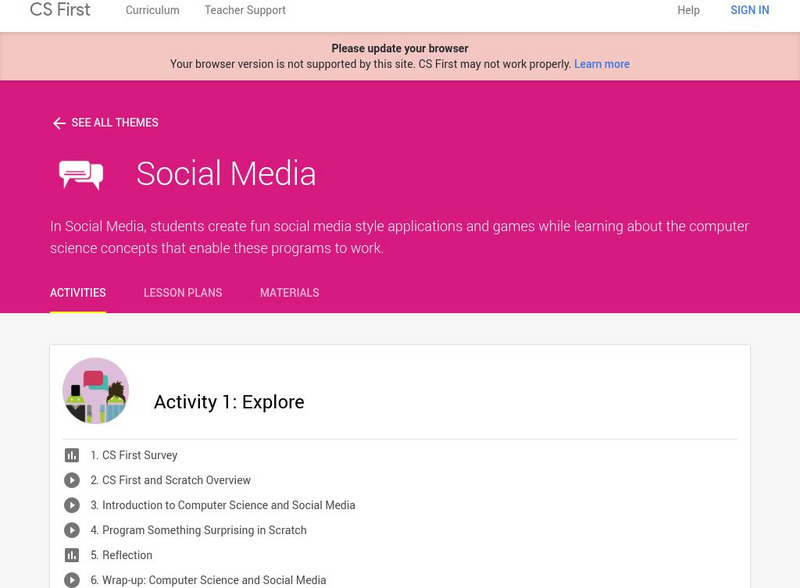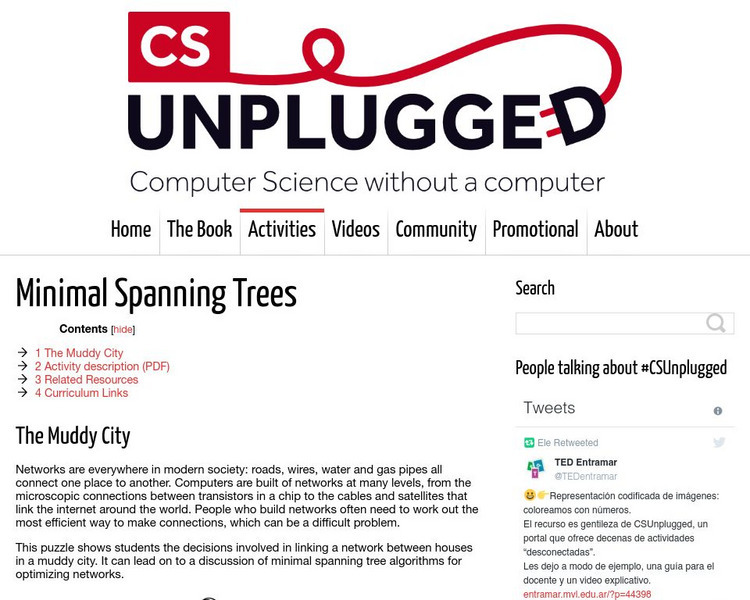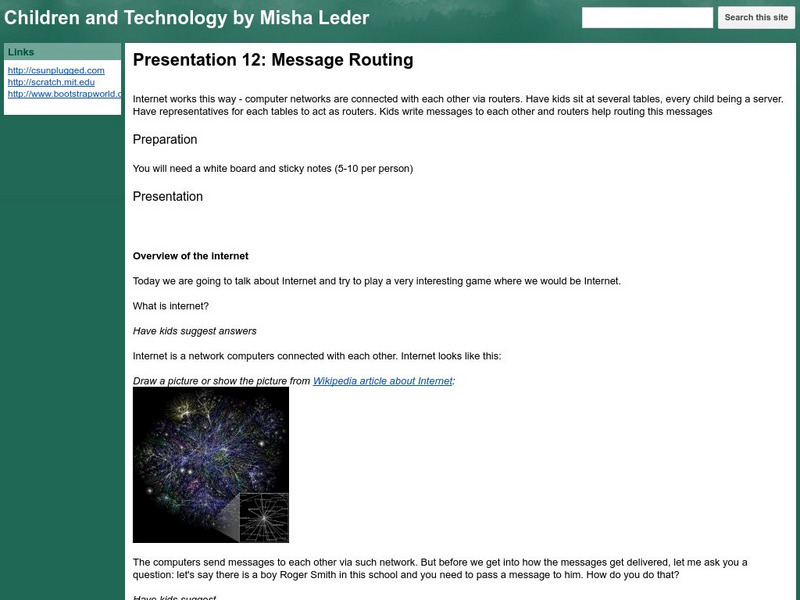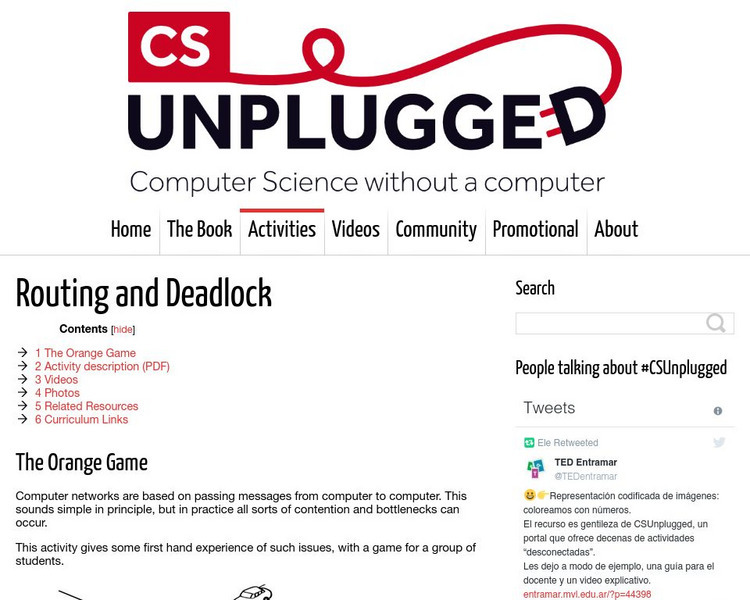Curated OER
Surveys
Students collect data from middle school survery. They tabulate percentages by grade level. They create a graph to display the survey results.
Curated OER
Around the World Alphabet Book
Learners explore the online dictionary portion of the EnchantedLearning.com website. They copy pictures and text to create an on-going, student-created classroom book which exposes them to different countries, cultures, animals, etc.
Curated OER
Rikki-Tikki Research
Fourth graders perform a search on mongooses on Internet Explorer and answer research questions.
Curated OER
Weather Or Not
Students use the internet to find pen pals to share in their weather experiment. Individually, they research the high and low temperatures for cities within the United States and email the results to their pen pal. They also develop a...
Curated OER
An Ounce of Prevention...
Students discuss current H.I.V. prevention strategies and adapt these strategies to address the spread of H.I.V. in developing countries. They analyze the results of an international AIDS conference called "The Urgent Search for an AIDS...
Curated OER
Xeriscaping In Your Community
Fourth graders participate in a service-learning project to design landscaping that maximizes water use and utilizes indigenous plant species.
Curated OER
Letters to Local and State Legislators
Pupils locate their local or state legislator's address. They write and send letters to their local and state legislators critiquing their voting record on environmental issues and sharing their own views on these issues.
Curated OER
K Is for Keelboat
Fifth graders investigate the significance of the keelboat in the Lewis and Clark expedition. They define the key themes of the expedition and classify them in prescribed format, an ABC book.
Curated OER
Careers
Learners discuss job choices, careers, and how they can affect lifestyles. They research a job they are interested in and write answers to questions about that job. They prepare a poster which includes information about the career they...
Curated OER
Classroom Triangles
Students use bearing measurements to triangulate and determine objects' locations. Working in teams of two or three, students must put on their investigative hats as they take bearing measurements to specified landmarks in their...
Curated OER
Like Comparing Bison and Fish
Fourth graders examine the cultures of early American Indians in North America and how geographic characteristics impacted the development of American Indian cultures. Students discuss Lewis and Clark, their journey, the Plains Indians,...
Curated OER
The Sum of the Parts
Second graders observe some everyday common objects in order to attempt to learn about simple systems and how they fit together. They observe small details in order to identify the parts of a whole design.
Curated OER
A Little Reminder to Take With You
High schoolers use information already gathered on a specific public health issue to create a public service message in the form of a bookmark. They consult multiple sources to compile sufficient information to create the public service...
Curated OER
Math: a World of Symmetry
Students expand their knowledge of quadrilaterals and identify basic symmetrical forms. Over three weeks, they explore the math, application, and discussion of symmetry. After conducting Internet research, students create symmetrical...
University of Canterbury
University of Canterbury: Cs Unplugged: Sorting Networks
A student team activity that demonstrates an approach to parallel sorting, or how much computation can be done at the same time. It can be done on paper, but the lesson becomes more meaningful if the students do it on a large scale,...
University of Canterbury
University of Canterbury: Cs Unplugged: Steiner Trees
Steiner trees are another way to approach finding efficient networks between points. This is another tough problem from computer science, converted into an activity which is easy to explain, with variations suitable for higher-level...
University of Canterbury
University of Canterbury: Cs Unpluggeed: Network Protocols
Learners learn what information makes up a protocol for bits of information added to messages to make sure they are sent over the internet.
Science Buddies
Science Buddies: Locating the Epicenter of an Earthquake
When an earthquake happens, how are scientists able to determine the original location of the quake? In this project, you'll use archived data from a network of seismometers to find out for yourself. You'll create your own seismograms...
Google
Cs Education at Google: Cs First: Gumball's Coding Adventure
Teaches basic computer science concepts using the programming language Scratch. In this activity, learners use characters from Cartoon Network's "The Amazing World of Gumball" to create an animated story.
Google
Cs Education at Google: Cs First: Social Media Theme
A set of eight activities that teach students basic computer science concepts using the programming language Scratch. Includes lots of additional supports for teachers. All materials are free and teachers sign in to create a class. This...
University of Canterbury
University of Canterbury: Cs Unplugged: Minimal Spanning Trees
This puzzle shows students the decisions involved in linking a network between houses in a muddy city. It can lead on to a discussion of minimal spanning tree algorithms for optimizing networks.
Curated OER
Google for Education: Children and Technology: Message Routing
Students simulate a server and are connected via computer networks. Representatives from each table act as routers, and as they write messages to each other, the routers help route these messages.
University of Canterbury
University of Canterbury: Cs Unplugged: Routing and Deadlock
Computer networks are based on passing messages from computer to computer. This sounds simple in principle, but in practice all sorts of contention and bottlenecks can occur. This activity gives some first hand experience of such issues,...



